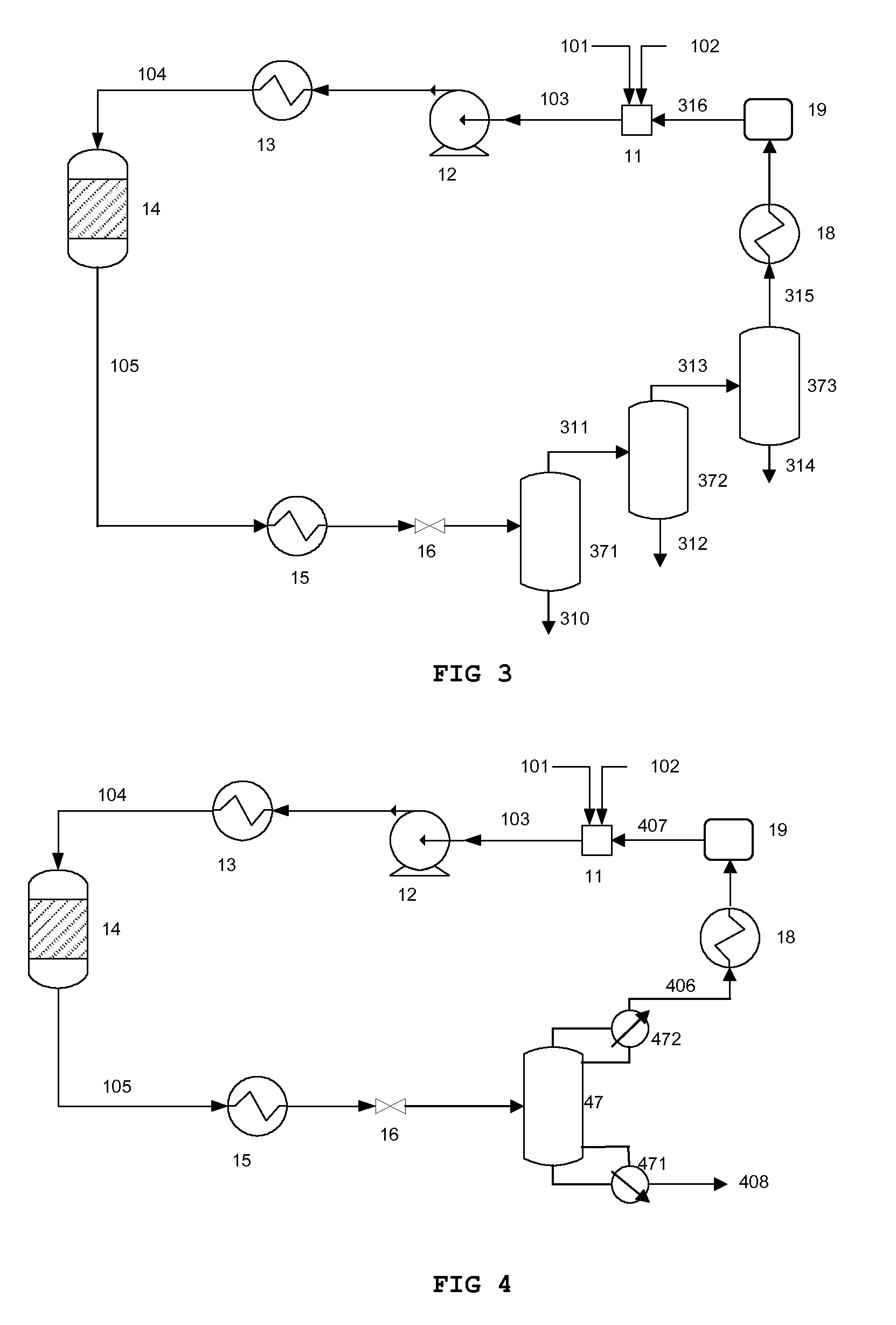Method for preparing fatty acid esters with alcohol recycling
- Summary
- Abstract
- Description
- Claims
- Application Information
AI Technical Summary
Benefits of technology
Problems solved by technology
Method used
Image
Examples
example 1
With Catalyst—Supercritical Methanol
[0086]A first example refers to the apparatus and method according to FIG. 1. “Fresh” methanol is pressurized to 1.2 MPa (not shown in the figure). A stream 102 of this “fresh” methanol is fed to mixing tank 11 at a rate of 1.2 g / min. Oil is pressurized to 1.2 MPa. A stream 101 of this oil is fed to mixing tank 11 at a rate of 8.1 g / min. A stream 107 of recycled methanol at a pressure of 1.2 MPa is fed to mixing tank 11 at a rate of 3.8 g / min. The mixture 103 is pressurized to 15 MPa and heated to 300° C. Thereafter it is fed to a tubular reactor 14. The residence time in the reactor, as calculated from the density under atmospheric conditions, is 15 minutes. The reactor is provided with MgO catalyst. After this step, more than 95% of the oil is converted to bio diesel. The reaction mixture 105 discharged from the reactor is cooled to 280° C. and depressurized to 1.2 MPa. Thereafter, the reaction mixture is fed to the flash separator 17. Separator...
example 2
With Catalyst—Subcritical Methanol
[0087]The second example refers to the apparatus and method according to FIG. 1. “Fresh” methanol is pressurized to 0.6 MPa (not shown in the figure). A stream 102 of this “fresh” methanol is fed to mixing tank 11 at a rate of 1.1 g / min. Oil is pressurized to 0.6 MPa. A stream 101 of this oil is fed to mixing tank 11 at a rate of 8.1 g / min. A stream 107 of recycled methanol at 0.6 MPa is fed to mixing tank 11 at a rate of 3.9 g / min. The mixture 103 is pressurized to 6 MPa and heated to 300° C. Thereafter it is fed to a tubular reactor 14. The residence time in the reactor, as calculated from the density under atmospheric conditions, is 15 minutes. The reactor is provided with MgO catalyst. After this step, the conversion efficiency from oil to bio diesel is more than 91%. The reaction mixture 105 discharged from the reactor is depressurized to 0.6 MPa. Thereafter, the reaction mixture is fed to the flash separator 17. Separator 17 is kept at a tempe...
example 3
Without Catalyst—Supercritical Methanol
[0088]A third example also refers to the apparatus and method according to FIG. 1. “Fresh” methanol is pressurized to 0.5 MPa (not shown in the figure). A stream 102 of this “fresh” methanol is fed to mixing tank 11 at a rate of 0.84 g / min. Oil is pressurized to 0.5 MPa. A stream 101 of this oil is fed to mixing tank 11 at a rate of 5 g / min. A stream 107 of recycled methanol is fed to mixing tank 11 at a rate of 6.66 g / min. The mixture 103 is pressurized to 19 MPa and heated to 350° C. Thereafter it is fed to a tubular reactor 14. The residence time in the reactor, calculated to the density under atmospheric conditions, is 15 minutes. The reactor is not provided with a catalyst. After this step, more than 85% of the oil is converted to bio diesel. The reaction mixture 105 discharged from the reactor is cooled to 280° C. and depressurized to 0.5 MPa. Thereafter, the reaction mixture is fed to the flash separator 17. Separator 17 is kept at a tem...
PUM
| Property | Measurement | Unit |
|---|---|---|
| Temperature | aaaaa | aaaaa |
| Temperature | aaaaa | aaaaa |
| Temperature | aaaaa | aaaaa |
Abstract
Description
Claims
Application Information
 Login to View More
Login to View More - R&D
- Intellectual Property
- Life Sciences
- Materials
- Tech Scout
- Unparalleled Data Quality
- Higher Quality Content
- 60% Fewer Hallucinations
Browse by: Latest US Patents, China's latest patents, Technical Efficacy Thesaurus, Application Domain, Technology Topic, Popular Technical Reports.
© 2025 PatSnap. All rights reserved.Legal|Privacy policy|Modern Slavery Act Transparency Statement|Sitemap|About US| Contact US: help@patsnap.com



